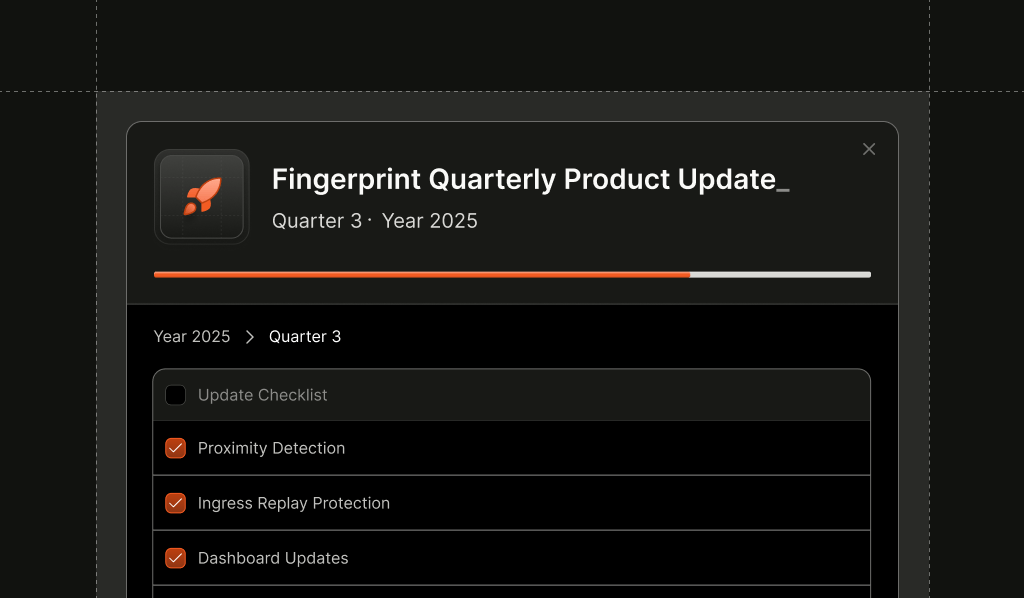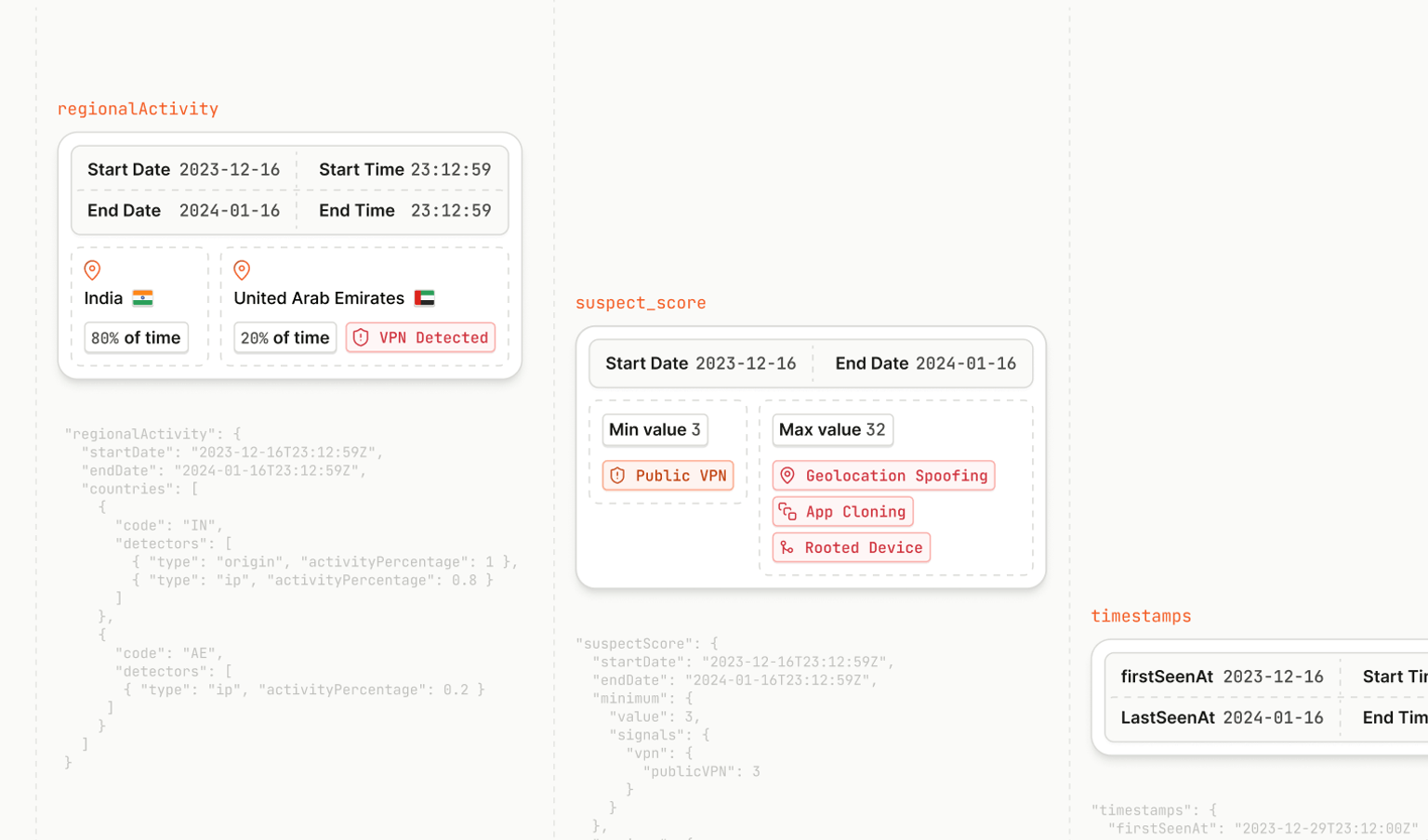
Summarize this article with
Fraud tactics are rapidly shifting, and what used to be rare edge cases are becoming everyday threats. Mobile devices are now involved in 74% of global digital payment fraud incidents.
Replay attacks, where attackers capture legitimate user traffic and resend it to impersonate real sessions, are on the rise. And more fraudsters are turning to so-called anti-detect browsers to rotate fingerprints, spoof environments, and appear as new users across multiple accounts.
That’s why this quarter, Fingerprint has released a wave of new features designed to help organizations gain greater insight into evolving threats, including mobile device–driven fraud and replay attacks. Fingerprint also made it easier than ever to recognize returning visitors so that you can improve their experiences while sharpening defenses against fraudsters.
We shipped all of these updates against the backdrop of ever-changing browsers and devices — maintaining our industry-leading device intelligence accuracy in the face of innovations like iOS 26 and Android 16.
Fingerprint’s latest updates will enable you to:
- Detect more fraud. Several new features significantly improve our ability to detect fraud. For mobile fraud, our new Proximity Detection for iOS and Android detects multi-accounting, device farms, and risky logins using location-based intelligence. We've also made significant enhancements to sharpen our existing Smart Signals, including improving Residential Proxy Detection by adding a confidence field, and upgraded our non-residential, data center proxy detection.
Finally, Ingress Replay Protection is designed to identify reused payloads from impersonation and replay attempts to strengthen your security measures. - Save implementation time. We’ve made it easier than ever to integrate Fingerprint to get faster, better insights. We’ve redesigned the integrations page to make understanding integration status and versioning easier. And we rolled out all-new statistical insights into Smart Signals and expanded filtering on the Identification page so you can filter by Smart Signal, SDK platform, and version. These user-friendly features are designed to make your experience with Fingerprint as smooth and efficient as possible.
For enterprises with multiple environments, we’ve added per-environment usage limits, webhooks, and the ability to filter Dashboard pages by environment to help identify issues in implementation, potential fraud behavior, and usage abuse by third-party clients. - Provide smoother journeys for your customers. To help you roll out the red carpet for your returning visitors, we’re testing a new feature that connects user journeys across in-app browsers, such as those in Instagram or Facebook, to native browsers in iOS. This helps improve user engagement and conversion rates, while strengthening identity resolution.
Let’s dive into the details of the newest features & how you can start using them.
Proximity Detection: Make location your strongest signal
Detect multi-accounting, device farms, and risky logins hiding in plain sight with Proximity Detection. Proximity Detection is Fingerprint’s new location-based signal that links co-located mobile devices and uncovers these hidden patterns. Along with a proximity ID, the signal includes metadata like precision radius and confidence level, giving teams richer context to act with confidence.
How teams use it:
- Detect device farms and mobile multi-accounting by grouping devices in the same physical area.
- Prevent potential account takeover attempts by flagging logins from unusual locations.
- Strengthen authentication flows with location-aware verification logic.
📌 What’s next? Update to mobile SDK 2.10.0 and explore Proximity Detection in our Android upgrade guide or the iOS upgrade guide.
Ingress Replay Protection: Detect reused payloads and stop stealthy impersonation
Replay attacks are on the rise — where attackers capture legitimate user traffic and resend it to impersonate real sessions. Ingress Replay Protection closes this blind spot by flagging requests that reuse previously seen signal payloads sent to Fingerprint. If a request looks identical to one already processed, you’ll see a replayed: true flag — no extra code or latency required.
How teams use it:
- Surface silent impersonation attempts using real user data.
- Feed high-confidence signals into risk scoring or step-up flows.
- Combine with behavioral signals to investigate coordinated abuse.
📌 What’s next? Learn more in our documentation and start using Ingress Replay Protection today.
Webviews in iOS share the same visitor ID as native Safari browsers
Because of iOS limitations, in-app browsers such as those in Instagram or Facebook have been identified as different from native browsers. This produced separate visitor IDs, limiting the ability to connect user journeys across browsers and resulting in disjointed user experiences and attribution gaps.
This new capability removes this limitation by providing the same visitor ID for native Safari and WKWebView sessions. As a result, you can:
- Improve user engagement and conversion rates: User journeys across different surfaces can be linked together to provide a seamless returning user experience.
- Strengthen identity resolution: Align authentication flows across in-app and regular browsers by assigning them the same visitor ID.
📌 What’s next? An alpha version of this capability is available for Enterprise customers. Contact your CSM to join the early-access program.
Dashboard updates: More control & better insights
We’ve released improvements that make it easier to manage your setup and investigate events with precision.
Expanded support for multiple environments
We’ve expanded environment support to give you more flexibility and control.
- Create Server API keys scoped to specific environments or keep them global.
- Scope webhooks to environments so they only report matching events.
- Apply monitoring alerts and usage limits per environment to stay on top of API activity.
New filters for Identification events
We’ve added more filtering options to help you quickly find exactly what you need.
- Filter by SDK platform and version to spot outdated clients.
- Filter by Smart Signals like Suspect Score, VPN Detection, Browser Bot Detection, Incognito Detection, VMs, Rooted/Jailbroken Device Detection, MitM Attack Detection, and more.
- Apply multiple filters at once and share filter URLs with teammates to speed up investigations.
📌 What’s next? Expanded environment controls and new filters are available to all customers. Explore them in Settings and on the Identification page.
Environment-scoped proxy integrations: Full flexibility across every deployment
With environment support, you can deploy and monitor multiple proxy integrations of the same type within one workspace. Each environment has its own keys, status page, and observability, giving you clean separation between production, staging, and client setups without extra workarounds required.
Why it matters
- Cleanly separate production, staging, and testing traffic.
- Manage multiple client integrations under a single subscription.
- Debug and monitor with environment-specific metrics and status pages.
- Avoid conflicts between environments while mirroring real deployment workflows.
📌 What’s next? Available to all customers. See the updated documentation to get started.
Get started with these new features today
Every feature is a step toward making Fingerprint more adaptive, transparent, and powerful for your team. Need help with any of these features? Contact our team for guidance or book a demo.


